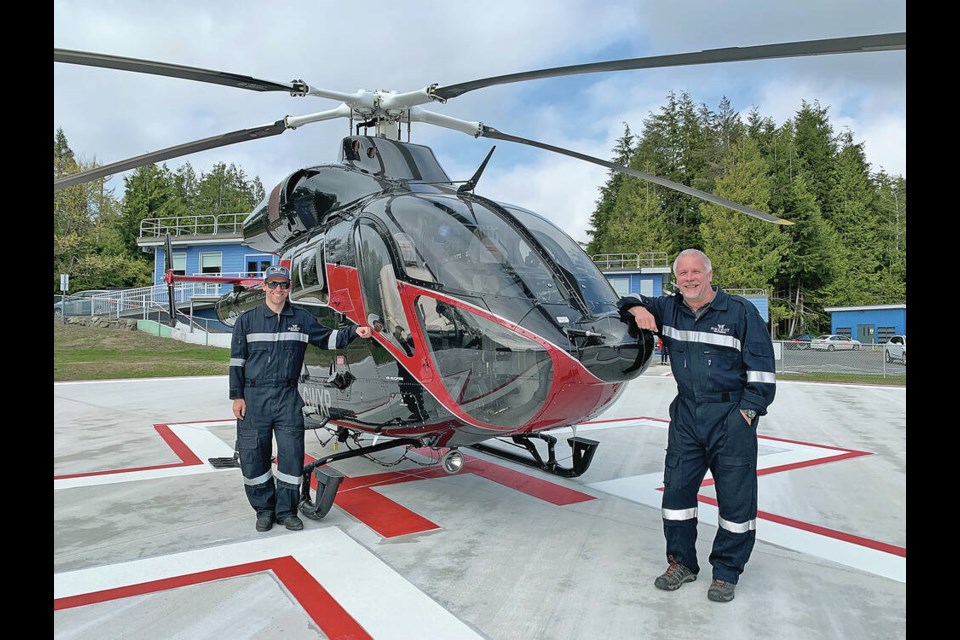A Parksville company has won a 10-year, $544-million contract to serve as B.C.’s air-ambulance helicopter provider, as the province pares down the number of companies it uses.
Ascent Helicopters Ltd.’s contract as the sole supplier of rotary-wing aircraft for air ambulance services in B.C. is expected to start between late fall 2024 and early spring 2025.
The company is importing seven new twin-engine Italian-built Leonardo AW169 helicopters for the job, awarded after a public request for proposals. It has subcontracted Babcock Canada to assist Ascent with non-flight operations, including maintenance and establishing facilities in bases around the province.
Ascent, a family-owned business headed by Trent and Withanie Lemke, already provides air ambulance services on Vancouver Island, as well as the Sunshine Coast and Lower Mainland. Trent is president and Withanie is vice-president.
Two other companies, Helijet International Inc. and Summit Helicopters, currently deliver helicopter ambulance service to the rest of the province, and will continue until Ascent takes over as the provincewide provider.
The contract is a “big vote of confidence for us,” said Trent Lemke. “It’s a great aircraft that we will be providing.”
Ascent will have one aircraft stationed in the Parksville-Qualicum area, two in Vancouver, and one each in Prince Rupert, Prince George and Kamloops. The seventh aircraft will be a spare.
The company is putting in new infrastructure in its additional bases, with upgraded accommodations for paramedics, Trent Lemke said.
Leonardo AW169 helicopters will be brought to Vancouver, where they will be fitted with medical equipment and supplies required by B.C. Emergency Health Services, before being inspected and approved by Transport Canada.
They are the first AW169s in Canada, Withanie Lemke said.
A similar provincewide contract for fixed-wing aircraft has been awarded to Carson Air of Kelowna, owned by Exchange Income Corp. It will use a fleet of King Air aircraft for the 10-year contract.
Every year, BCEHS arranges air ambulances for more than 7,800 patients, using both helicopters and fixed-wing aircraft. About two-thirds of patients are carried by fixed-wing aircraft, with the remainder by helicopters.
Aircraft are commonly used to transfer patients from one hospital to another, while helicopters, which can land in remote areas, such as on a beach or on a road, are dispatched to rugged and difficult-to-reach locations in emergencies.
Of the 2,390 helicopter transports last year, 1,778 were for patient transfers between facilities and 612 were for medical events, BCEHS said.
The Lemkes, who started the business in 20o5, plan to expand their Parksville hanger where Ascent’s air ambulance service is based.
Trent Lemke said he has been fascinated by flying since childhood, and started out by flying float and bush planes in Northern B.C., the Yukon and Alaska. He anticipates the provincewide contract will result in a 40 per cent growth in the business.
Ascent has 15 to 17 helicopters working at one time, with about 70 employees. Another 40 to 50 will be hired as the air ambulance service expands.
Power line utility work is a major component of business for Ascent, which operates in Canada as far east as Newfoundland and also works in the U.S. and Turkey. “We specialize in certain things that other people in the industry don’t,” Trent Lemke said.
The company owns the helicopters and uses its own flight and maintenance staff. BCEHS supplies the paramedics — often highly skilled critical-care paramedics needed for emergencies.
The new aircraft’s capabilities will translate into a higher level of care for patients, Trent Lemke said. Modern features including advanced avionics (electronic systems) will reduce the time it takes to reach and start caring for patients.
Key attributes of the AW169 include its ability to meet government standards to use helipads in urban areas. Its twin engines allow it to operate on one engine if necessary. Another bonus is the AW169’s roomy interior, which gives paramedics more room to work, he said.
Technological advances give it a longer range, which means fewer fuel stops.
Each helicopter will have an automatic loading system that will pick up a stretcher and slide it and lock it down inside the cabin. The loading feature assists paramedics, who can be injured when lifting stretchers, and will reduce their physical workload.
Ascent was a leader in the province in adding night-vision technology, which has been a “huge game-changer for the air medivac industry,” Trent Lemke said.
“One of our first customers for night-vision was Parks Canada during a rescue on the West Coast Trail at about one o’clock in the morning” a few years ago, he said.
The Leonardo company describes its AW169s as having “superior range and safety,” versatility and the ability to operate in challenging conditions.
Its glass cockpit and latest-generation avionics provide exceptional external visibility, the company said.
“This maximizes situational awareness and minimizes pilot workload during day and night operations, increasing operational safety.”
>>> To comment on this article, write a letter to the editor: [email protected]
Note to readers: This story has been updated to include details of the fixed-wing contract.




